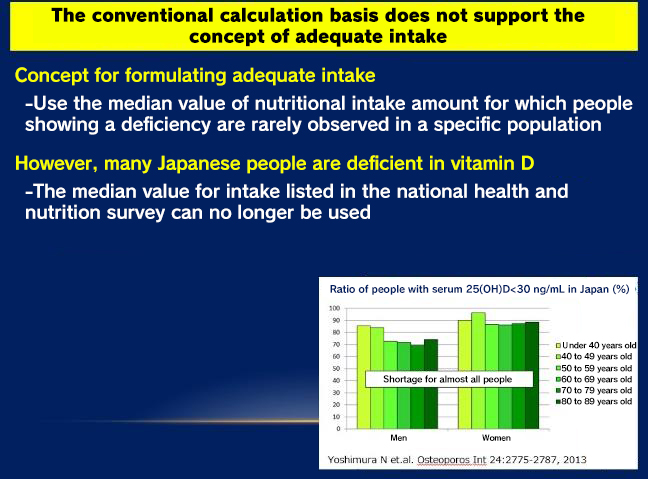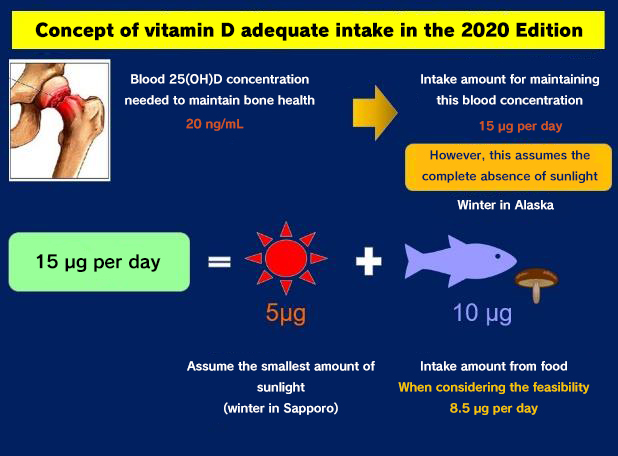

Among fat-soluble vitamins, major revision were made to vitamin D in the 2020 Edition of the Dietary Reference Intakes for Japanese.
A major characteristic of vitamin D is that a large amount is produced by the skin, not just by ingestion. Vitamin D taken into the body via ingestion and production in the skin is converted to 25-hydroxyvitamin D [25(OH)D] in the liver. The blood concentration reflects the amount of vitamin D due to oral ingestion and production in the skin. It also has a long half-life in blood, and is therefore used as the optimum indicator of vitamin D nutritional status.

Until now, the adequate intake of vitamin D has been 5.5 µg per day. This intake prevents increase of the serum parathyroid hormone concentration (increases due to vitamin D deficiency and promotes bone resorption) and maintains the blood 25(OH)D concentration at 20 ng/mL. However, there are significant problems with this intake. The first problem is that blood levels and intake data are obtained from different populations. Specifically, it uses the median vitamin D intake in the national health and nutrition survey for gender and age groups, in which the average blood 25(OH)D concentration was 20 ng/mL or higher. The second problem is that a majority of Japanese people are vitamin D deficient, regardless of age. Approximately 40% to 50% of Japanese are below 20 ng/mL. In other words, it is possible that about half of the subjects of the national health and nutrition survey are vitamin D deficient. The adequate intake is defined as “the amount sufficient to maintain a certain nutritional status in a specific population.” In other words, it is the amount at which people showing a deficiency are rarely observed in a specific population. Therefore, using the median vitamin D intake of the national health and nutrition survey contradicts the concept of the intake guidelines. Consequently, the calculation basis was significantly revised in the 2020 Edition.

The dietary reference intakes of the United States and Canada were used as reference for the 2020 Edition. Here, the recommended amount of vitamin D for maintaining a serum 25(OH)D concentration of 20 ng/mL, which is most effective in preventing bone fractures in the complete absence of sunlight (winter in Alaska), is 15 µg per day for people under 70 years of age. When adapting this reference intake for Japanese people, it was calculated that 10 µg per day should be supplemented by taking into account the minimum amount of vitamin D that is assumed to be produced through exposure to sunlight (assuming production of 5.0 µg per day in winter in Sapporo). However, it is necessary to consider the feasibility of dietary reference intake, and is therefore necessary to ascertain the current vitamin D intake of Japanese people. Since about 80% of the total intake of vitamin D by Japanese people is derived from fish and shellfish, the daily intake of vitamin D varies greatly. In this case, it is not appropriate to refer to the data of the national health and nutrition survey, which is a one-day survey and includes the possibility of excessive underreporting. Accordingly, using the data of a dietary survey conducted in a relatively detailed manner for 4-day periods in 4 seasons (total of 16 days), the current vitamin D intake by Japanese people was calculated to be about 8.3 µg per day. This value was rounded up to 8.5 µg per day to arrive at the adequate intake. However, the footnotes in the table also mention that “it is important to take into account the hours of sunshine when ingesting vitamin D.” In other words, the higher the risk of vitamin D deficiency, the greater the amount that should be ingested. We have developed a simple questionnaire (VDDQ-J) for vitamin D deficiency risk that includes questions on exercise habits, status of exposure to sunlight, sunscreen use, and fish intake. Moving forward, while continuing to utilize the questionnaire, in order to calculate a more appropriate vitamin D intake, we must conduct research aimed at clarifying the interrelationship between sunlight exposure time, habitual intake of vitamin D, and serum 25(OH)D concentration in Japanese people.
|